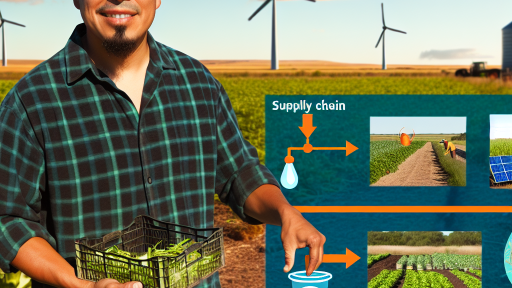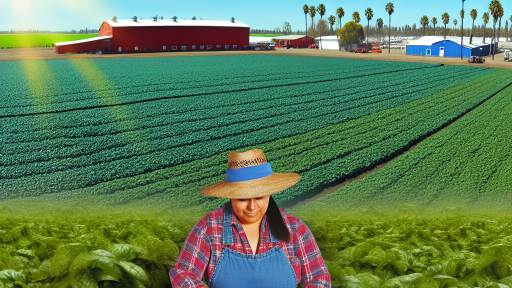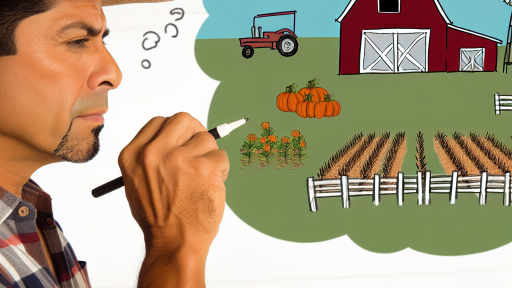Identifying Potential Risks: A Comprehensive Assessment
Understanding Risk Categories
Begin by understanding the various risk categories that affect farms.
Financial risks are crucial and can stem from market fluctuations.
Production risks arise from climate change and pest infestations.
Operational risks involve machinery breakdowns and labor shortages.
External risks include policy changes and global market trends.
Conducting a Detailed Assessment
Start by evaluating your current farming practices.
Identify areas prone to financial losses.
Review your operational procedures for potential inefficiencies.
Analyze historical data to recognize patterns in production risks.
Engage with industry professionals for their insights.
Utilizing Risk Assessment Tools
Consider using risk assessment tools to enhance your analysis.
Software solutions can provide valuable data insights.
Checklists can help ensure all potential risks are considered.
Models can simulate different scenarios to forecast potential impacts.
Engaging Stakeholders
Involve key stakeholders in the risk assessment process.
Transform Your Agribusiness
Unlock your farm's potential with expert advice tailored to your needs. Get actionable steps that drive real results.
Get StartedShare findings with your team to foster collective ownership.
Solicit input from suppliers and customers regarding external risks.
This collaboration can lead to identifying new risks.
Prioritizing Risks
Once risks are identified, prioritize them based on their impact.
Account for both the likelihood of occurrence and potential loss.
Focus your resources first on the highest priority risks.
Regularly revisit and adjust your priorities as conditions change.
Insurance Options for Farmers: Protecting Your Assets
Understanding Different Types of Farm Insurance
Farm insurance provides crucial protection for your agricultural assets.
Additionally, it helps to cover risks associated with farming activities.
Several types of farm insurance exist, each serving unique purposes.
Property Insurance
Property insurance safeguards your physical assets, like barns and equipment.
Consider policies that cover natural disasters, theft, and vandalism.
Evaluate the coverage limits to ensure they meet your needs.
Crop Insurance
Crop insurance minimizes financial loss during adverse events.
This includes droughts, floods, and other natural calamities.
Farmers should explore federal programs designed to support crop insurance.
Liability Insurance
Liability insurance protects against claims resulting from accidents.
These accidents may occur on your property or due to farm operations.
This coverage can include injuries to visitors or damage to others’ property.
Livestock Insurance
Livestock insurance protects against loss of your animals due to various risks.
These risks may involve disease, theft, or accidents.
Farmers need to assess the type of livestock they breed for tailored coverage.
Umbrella Policies
Umbrella policies provide additional coverage above your primary insurance limits.
This extra protection can be valuable for high-risk farming operations.
Showcase Your Farming Business
Publish your professional farming services profile on our blog for a one-time fee of $200 and reach a dedicated audience of farmers and agribusiness owners.
Publish Your ProfileConsider an umbrella policy to enhance your overall risk management strategy.
Choosing the Right Insurance Provider
Choose an insurance provider that specializes in agricultural coverage.
Research providers’ reputations and client reviews for better insight.
Communicate your unique needs with potential insurers to tailor coverage.
Reviewing Your Insurance Needs Regularly
Inspection of your insurance policy should occur at least once a year.
Replace outdated coverage to reflect changes in your farming operation.
Stay informed about new insurance options and updates in the industry.
Diversification Strategies: Mitigating Financial Risks
Importance of Diversification
Diversification plays a key role in financial risk management for farmers.
It reduces dependence on a single crop or livestock type.
Consequently, farmers can buffer against market fluctuations.
Additionally, it enables better resource utilization across various sectors.
Types of Diversification
Farmers can diversify in multiple ways.
- Crop Diversification: Planting different crops each season.
- Livestock Diversification: Raising various types of livestock.
- Geographic Diversification: Expanding operations into different regions.
- Product Diversification: Offering processed goods or value-added products.
Benefits of Crop Diversification
Crop diversification enhances soil health and reduces pest issues.
It also spreads risk across different growing conditions.
Moreover, diverse crops can attract a broader customer base.
Farmers often experience more stable income with varied crops.
Implementing Livestock Diversification
Diversifying livestock can optimize feed use and management resources.
For example, combining cattle with poultry can enhance waste recycling.
It also provides multiple income streams throughout the year.
Enhancing Geographic Diversity
Expanding into new regions can mitigate local market risks.
Different geographic areas may experience varying demands and prices.
Additionally, spreading assets can protect against localized disasters.
Exploring Product Diversification
Transforming raw products into marketable goods boosts profitability.
Examples include making cheese from milk or jams from fruit.
This strategy also taps into niche markets and consumer trends.
Furthermore, it creates opportunities for value-added sales.
Cultivating Market Knowledge
Stay informed about market trends and consumer preferences.
Research helps in identifying which crops or livestock will thrive.
Participating in agricultural workshops can improve knowledge.
Networking with other farmers can also provide valuable insights.
Continuous Evaluation
Regularly assess the effectiveness of diversification strategies.
Track financial performance and production metrics closely.
Adaptation to changing market conditions is essential.
Flexibility allows farmers to pivot their strategies effectively.
Find Out More: Sustainable Livestock Farming Practices for Environmental Stewardship
Crisis Management Plans: Preparing for Natural Disasters
Understanding the Importance of Preparedness
Preparedness is essential for any farm facing natural disasters.
Effective planning reduces risks and protects assets.
Moreover, it ensures the safety of personnel and livestock.
Assessing Potential Risks
Begin by identifying the types of disasters that could affect your farm.
Common risks include floods, droughts, storms, and wildfires.
Showcase Your Farming Business
Publish your professional farming services profile on our blog for a one-time fee of $200 and reach a dedicated audience of farmers and agribusiness owners.
Publish Your ProfileEvaluate past occurrences to understand local hazards better.
This assessment guides the development of specific plans.
Developing a Comprehensive Crisis Management Plan
Your plan should outline clear roles and responsibilities.
Include contact information for local emergency services.
Ensure it addresses immediate actions during a disaster.
Additionally, establish long-term recovery strategies.
Creating an Emergency Response Team
Form a team responsible for disaster management.
Train team members in emergency procedures and first aid.
Conduct regular drills to maintain readiness and confidence.
Establishing Communication Channels
Establish reliable communication methods for emergencies.
Consider both traditional and digital options.
Keep all staff informed about communication protocols.
Implementing Safety Measures
Install necessary equipment and supplies in advance.
This includes first aid kits, flashlights, and food provisions.
Conduct regular maintenance on farm machinery and buildings.
Structural improvements can significantly reduce damage risks.
Insurance and Financial Preparation
Review insurance policies to ensure adequate coverage.
Include natural disaster provisions in your plans.
Consider emergency funds for unexpected expenses.
Consult financial advisors to discuss potential impacts.
Training and Drills
Regular training ensures everyone knows their role in emergencies.
Conduct drills for various disaster scenarios throughout the year.
Evaluate the effectiveness of each drill and make adjustments.
Continuously Review and Improve Your Plan
Review your crisis management plan periodically.
Update it based on new risks or changes in the farm’s operations.
Involve team members in this process for diverse perspectives.
Stay informed about best practices in disaster preparedness.
Explore Further: Comprehensive Tax Planning Strategies For Farmers And Agribusinesses
Regulatory Compliance: Ensuring Legal Protection
The Importance of Regulatory Compliance
Regulatory compliance protects farmers from legal issues.
It ensures adherence to laws governing agriculture.
Ignoring regulations can lead to severe penalties.
Furthermore, compliance enhances a farm’s credibility.
Key Regulatory Areas to Consider
Farmers should focus on several key regulatory areas.
- Environmental regulations dictate how farms use land.
- Labor laws impact employment practices on farms.
- Health and safety regulations protect workers.
- Tax compliance ensures accurate reporting and payments.
Staying Updated on Legal Requirements
Laws and regulations frequently change in agriculture.
Farmers should regularly consult legal resources.
Joining local agricultural organizations can provide updates.
Moreover, attending workshops helps in understanding compliance.
Implementing Compliance Practices
Develop a compliance plan tailored to your farm’s needs.
Document all processes related to regulations.
Training staff ensures everyone understands their responsibilities.
Showcase Your Farming Business
Publish your professional farming services profile on our blog for a one-time fee of $200 and reach a dedicated audience of farmers and agribusiness owners.
Publish Your ProfileConduct regular audits to identify potential compliance gaps.
Engaging with Legal Expertise
Consulting with agricultural attorneys is beneficial.
An attorney can offer guidance based on specific circumstances.
Additionally, legal experts help navigate complex regulations.
Establish a relationship with a trusted legal professional.
Learn More: Choosing the Best Insurance for Your Farm

Employee Training: Minimizing Operational Risks
Importance of Employee Training
Effective employee training is vital for reducing operational risks.
Trained staff can identify potential hazards more quickly.
Moreover, they can apply safety procedures correctly.
Developing a Comprehensive Training Program
A comprehensive training program covers all critical areas.
Include safety protocols in every training module.
Furthermore, provide training on equipment handling and maintenance.
Regularly update training materials to reflect current practices.
Incorporating Hands-On Learning
Hands-on training enhances understanding and retention.
Allow employees to practice in simulated environments.
This prepares them for real-life situations more effectively.
Continuous Training and Refresher Courses
Continuous training keeps staff informed about new procedures.
Offer refresher courses annually to reinforce knowledge.
This approach minimizes risk from outdated practices.
Measuring Training Effectiveness
Measuring training effectiveness helps identify areas for improvement.
Utilize assessments and feedback to gauge understanding.
Adjust training programs based on evaluation results to maintain relevance.
Cultivating a Safety Culture
A culture of safety encourages employees to prioritize health.
Recognize and reward safe practices among staff members.
This fosters a proactive environment in risk management.
Engaging External Experts
Involve external experts for specialized training sessions.
Their insights can cover complex topics effectively.
Additionally, they bring fresh perspectives to your training programs.
You Might Also Like: Cost Control Methods For Sustainable Farm Financial Health
Technology in Risk Management: Utilizing Data and Analytics
Importance of Data Analytics in Agriculture
Data analytics plays a crucial role in modern agriculture.
It enables farmers to make informed decisions based on real-time information.
Additionally, data helps in predicting trends and identifying risks early.
Types of Data to Collect
Farmers should focus on various types of data.
This includes weather patterns, crop performance, and soil health metrics.
Market data can also provide insights into pricing trends.
Tools for Data Collection
Farm management software offers valuable data insights.
Moreover, IoT devices collect information on equipment and environmental conditions.
Drone technology can assist in monitoring crop health and growth patterns.
Analyzing Collected Data
Analyzing data is essential for effective risk management.
Farmers can use statistical models to forecast yield or assess risks.
Showcase Your Farming Business
Publish your professional farming services profile on our blog for a one-time fee of $200 and reach a dedicated audience of farmers and agribusiness owners.
Publish Your ProfileMachine learning algorithms can identify patterns that humans may overlook.
Implementing Data-Driven Strategies
Once data is analyzed, implementing strategies becomes straightforward.
Farmers can optimize their planting schedules based on analytics.
Additionally, they can adjust irrigation and fertilization practices accordingly.
Benefits of Using Technology
Utilizing technology for risk management yields numerous benefits.
It increases operational efficiency and reduces costs.
Furthermore, it enhances crop yields and overall farm profitability.
Challenges in Adopting Technology
Despite its benefits, challenges exist in adopting technology.
Cost and lack of technical knowledge can hinder farmers.
Additionally, data security concerns may arise with online tools.
Future of Technology in Agriculture
The future of agriculture relies heavily on technology and analytics.
Advancements will continue to improve risk management strategies.
Furthermore, technology can enhance resilience against climate change impacts.
Building Strong Relationships: Networking with Local Resources
Identifying Key Local Resources
Begin by mapping out local agricultural organizations.
Look for cooperative extensions in your area.
Identify agricultural suppliers and their support services.
Connect with local universities that focus on agriculture.
These resources can provide invaluable expertise and assistance.
Establishing Connections
Attend local farming events and workshops regularly.
Participate in regional agricultural fairs and exhibitions.
Engage with fellow farmers during networking events.
Join online forums and social media groups focused on agriculture.
Building relationships with other farmers creates a support network.
Utilizing Collaborative Opportunities
Collaborate with local farmers for bulk purchasing discounts.
Join a community-supported agriculture (CSA) program.
Participate in cooperative marketing initiatives.
Sharing resources reduces costs and boosts productivity.
Engaging with Local Government and Agencies
Reach out to local agricultural government agencies.
Understand available programs and incentives for farmers.
Attend meetings and workshops hosted by these agencies.
Participate in discussions about local agricultural policies.
Your voice can influence decisions affecting local farmers.
Leveraging Technology for Networking
Use social media platforms to connect with other farmers.
Create a website or blog to share your farming experiences.
Join online platforms focused on agricultural innovation.
Utilizing technology can broaden your reach and influence.
Sharing Knowledge and Resources
Offer to mentor newer farmers in your community.
Schedule workshops to share best practices with others.
Encourage discussions about challenges and solutions.
Sharing knowledge builds trust and respect within the community.
Showcase Your Farming Business
Publish your professional farming services profile on our blog for a one-time fee of $200 and reach a dedicated audience of farmers and agribusiness owners.
Publish Your ProfileAdditional Resources
HPAI in Livestock | Animal and Plant Health Inspection Service




